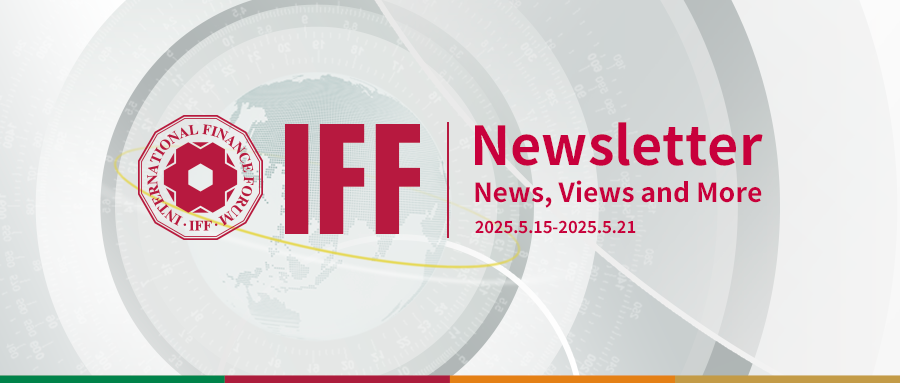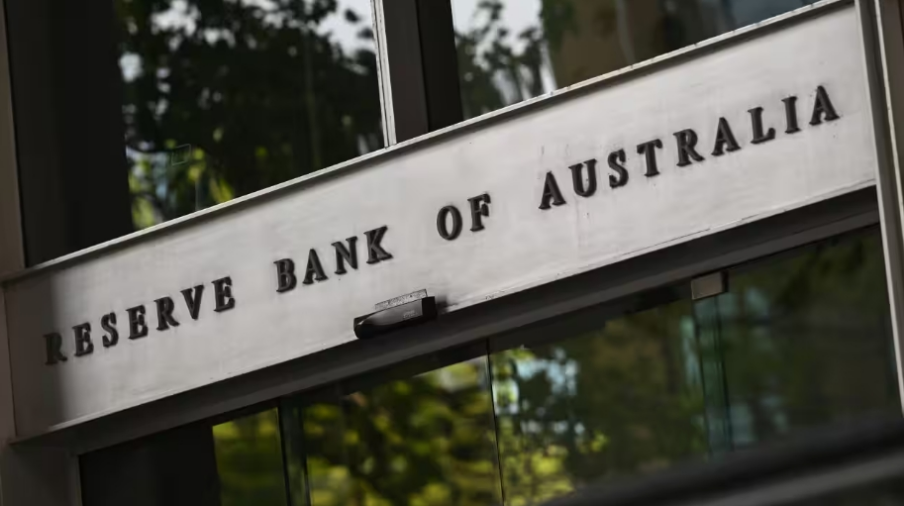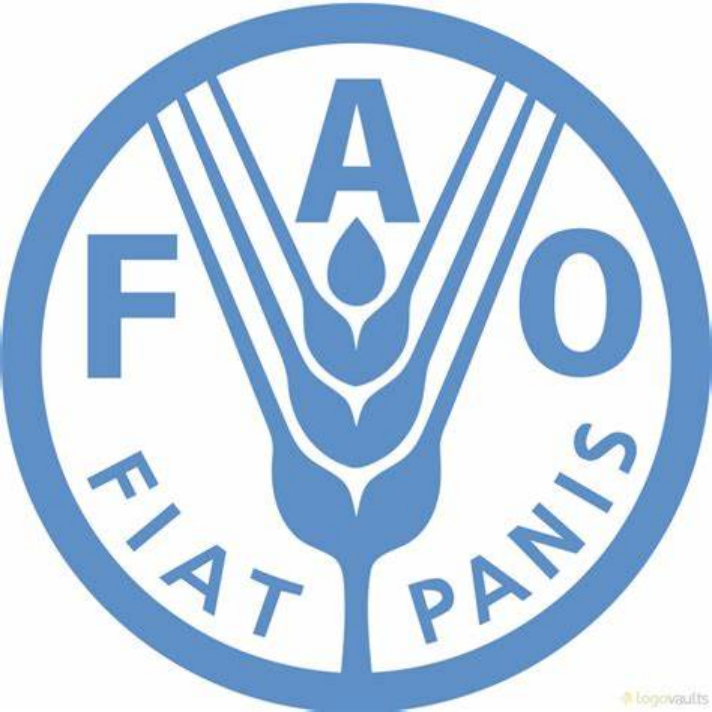HOME>NEWS CENTER>Newsletters
IFF Newsletter | China's Tax Revenue Grows in April
TIME:2025-05-23

From the Editor
China's industrial production, consumption, and investment growth slowed in April, despite proactive macroeconomic policies aimed at countering US tariff impacts, according to data released by the National Bureau of Statistics (NBS) on May 19.
Industrial added value of major enterprises rose 6.1% year-on-year in April, down from March's 7.7% growth. Retail sales grew 5.1%, lower than the previous month's 5.9%, while fixed-asset investment increased 4% in the first four months, compared to 4.2% in Q1.
Moody's Ratings downgraded U.S. long-term issuer and senior unsecured ratings to Aa1 from Aaa on May 16, citing rising government debt and interest payment ratios. Simultaneously, Moody's simultaneously revised the U.S. sovereign rating outlook from negative to stable.
This marks the first time all three major international credit agencies - Moody's, S&P Global Ratings, and Fitch Ratings - have rated the United States below their top tier.

On May 15, 2025, the International Finance Forum (IFF) convened an important meeting at the IFF Hong Kong Center, attended by IFF Board Member and former Deputy Prime Minister of Kazakhstan, Kairat Kelimbetov, his delegation, and IFF Secretariat members. The discussions centered on deepening the "Belt and Road" initiative, developing regional financial hubs, and enhancing international cooperation, highlighting IFF's leading role in global green finance and regional economic integration.
The meeting established a strategic focus on "Consolidating the Asia-Pacific, Deepening Engagement in the Middle East, and Connecting with Europe." This approach not only maintains the hub function of the IFF Hong Kong Center but also strengthens global governance participation. As initiatives unfold, IFF aims to reinforce its position as a premier international financial dialogue platform, contributing to global economic recovery.
China News
China’s Tax Revenue Grows in April for First Time This Year

China's tax revenue rose in April for the first time this year, mainly because of stable economic growth despite challenges such as lower corporate profits and decreased revenue from import-related taxes,according to data released by the Ministry of Finance on May 20.
Tax revenue increased 1.9 percent last month from a year earlier. And in the first four months of the year, tax revenue fell 2.1 percent year on year to CNY6.56 trillion (USD909.5 billion), narrowing from a 3.5 percent decline in the first quarter thanks to April’s figure, the data showed.
General public budget revenue, the sum total of tax and non-tax revenues, inched down 0.4 percent on an annual basis to CNY8.06 trillion in the four months ended April 30, while income from national government-managed funds fell 6.7 percent to CNY1.26 trillion. Both narrowed declined from the first quarter.
China’s Industrial, Consumption, and Investment Growth Slow in April Amid US Tariff Pressures

Growth in China’s industrial production, consumption, and investment slowed in April, despite the country’s proactive macroeconomic policies aimed at mitigating the impact of hiked US tariffs, according to data released by the National Bureau of Statistics (NBS) on May 19.
The added value of China’s major industrial enterprises rose 6.1 percent year-on-year in April, compared with a 7.7 percent increase in March, NBS said.
Retail sales of consumer goods climbed 5.1 percent last month, down from a 5.9 percent rise in the previous month. Fixed-asset investment grew 4 percent in the first four months of this year, easing from a 4.2 percent increase recorded in the first quarter.
UK Edges Out China as Second‑Largest US Creditor in March

The United Kingdom surpassed China to become the United States’ second-largest creditor in March. China had held the title since October 2016, according to data released by the US Department of the Treasury on May 16.
China trimmed its holdings of US Treasury bonds by USD18.9 billion to USD765.4 billion in March from the previous month.
Meanwhile, the UK added USD29 billion to its US Treasury holdings, taking them to USD779.3 billion and exceeding China for the first time. Japan, the US’ largest creditor, raised its haul by USD4.9 billion to USD1.1308 trillion.
China has held less than USD1 trillion of US Treasury bonds since April 2022. It swelled its stash of Treasuries three times last year, in April, June, and November, while it trimmed them in the nine other months. This January and February, it increased them by USD1.8 billion and USD23.5 billion, respectively.
China Adds Six More Countries to Visa-Free List in Boost to Tourism

China has announced an expansion of its visa waiver policy on May 15, adding six more countries to the list of exemptions, in a move set to further bolster the nation’s tourism industry.
A reciprocal agreement between China and Uzbekistan will take effect on June 1, allowing visa-free stays of up to 30 days per visit and no more than 90 days in any 180-day period, China’s foreign ministry said.
The ministry also announced the expansion of visa-free access for passport holders from Brazil, Argentina, Chile, Peru, and Uruguay. In a one-year trial also starting June 1, citizens of these countries can enter China without a visa for business, tourism, family visits, exchanges, or transit, provided they remain for no more than 30 days.
Data from Chinese online travel agency Trip.Com indicates significant inbound tourism potential from these nations, as interest in visiting China had been growing fast even before the latest expansion of the country’s visa-free policy.
China Is Speeding Policy Rollout to Steady Economy, Tackle Cutthroat Competition, NDRC Says

China is accelerating the rollout of measures aimed at stabilizing the economy and employment, advancing high-quality development, and curbing cutthroat competition, with most policies expected to take effect by the end of next month, an official at the country’s top planner said on May 20.
The National Development and Reform Commission will continue to improve its policy toolbox to steady the economy and employment and ensure that necessary measures can be promptly introduced and implemented when needed, NDRC spokesperson Li Chao said at a press conference.
The revision and expansion of the Catalogue of Encouraged Industries for Foreign Investment have completed the public consultation stage and are now being revised and improved based on the feedback, Li said. The updated catalog will fully reflect high-end manufacturing, the digital economy, and other areas.
The NDRC will work with other government departments to expand the real-world situations for the low-altitude economy in a gradual and orderly manner under the premise of strictly controlling risks and ensuring safety, Li said. The authorities will also crack down on illegal activities, such as unlicensed pilots, low-altitude aircraft operating without airworthiness certificates, and unapproved flight activities, he added.
China's Special-Mention Loan Issuance Falls in First Quarter

The ratio of special-mention loans fell to 2.18 percent from 2.22 percent last quarter, according to data released by the China Financial Regulatory Administration on May 16. The decline indicated the sector's improved risk resilience.
Chinese financial institutions' domestic and foreign currency assets rose 6.7 percent year-on-year to CNY458.3 trillion (USD63.57 trillion) as of March 31, the data showed.
Commercial banks held NPLs worth CNY3.4 trillion (USD471.6 billion) as of the end of the first quarter, up CNY157.4 billion (USD21.8 billion) from Dec. 31. Meanwhile, the NPL ratio climbed 0.01 percentage point to 1.51 percent.
The provision coverage ratio of commercial lenders stood at 208.13 percent as of the end of last quarter, down from 211.19 percent at the end of last year; the loan loss provision ratio fell to 3.15 percent from 3.18 percent.
Commercial banks had a capital adequacy ratio of 15.28 percent, Tier 1 ratio of 12.18 percent, and core Tier 1 ratio of 10.70 percent in the first quarter, according to the China Financial Regulatory Administration.
Newsletter
International News
Australian Central Bank Cuts Interest Rate to Two-Year Low

Australia's central bank on May 20 cut its official cash rate by 25 basis points to 3.85 percent, the lowest level in two years.
The monetary policy board of the Reserve Bank of Australia (RBA) said in a statement that it made the decision at its meeting in Sydney on Tuesday, adding that maintaining low and stable inflation is the priority.
It is the second time in 2025 that the RBA has lowered interest rates following a cut in February, which was the first since November 2020, and marks the rate's lowest level since May 2023.
The monetary policy board said that inflation has fallen "substantially" since the peak in 2022, as higher interest rates have been working to bring aggregate demand and supply closer towards balance, but it also warned of "uncertainties" about the outlook for economic activity in Australia and abroad.
Britain, EU Strike Deal to Boost Trade, Youth Mobility, Environmental Cooperation

Britain and the European Union (EU) have reached a wide-ranging agreement expected to boost the British economy by nearly 9 billion pounds (approximately 12.06 billion U.S. dollars) by 2040, Downing Street announced on May 19.
The deal was unveiled ahead of a high-profile summit with EU leaders held in London on Monday. A key feature of the agreement is the introduction of a youth mobility scheme. Downing Street described it as "capped and time-limited," and modeled on similar arrangements Britain has with countries such as Australia and New Zealand.
The agreement also addresses illegal migration, with both sides committing to cooperation "on returns and a joint commitment to tackle channel crossings."
In the fisheries sector, the two sides have also agreed on a new 12-year deal securing continued British access to EU waters. According to the news release, the agreement ensures EU vessels will not increase their catch in British waters. To support domestic fisheries, the British will invest 360 million pounds to modernize their fleets and upgrade their technology and equipment. British fishing businesses will also benefit from reduced costs and red tape under the sanitary and phytosanitary (SPS) agreement, facilitating exports.
The deal also includes environmental commitments. The two sides agree to link their Emissions Trading Systems to "avoid businesses being hit by the EU's carbon tax due to come in next year."
EU Slashes Growth Forecasts Over Higher US Tariffs, Uncertainty

The European Commission on May 19 sharply downgraded its economic growth outlook for the European Union (EU), citing the impacts of higher U.S. tariffs and persistent uncertainty.
In its Spring 2025 Economic Forecast, the commission cut its projections for real gross domestic product growth for the 27-country bloc to 1.1 percent in 2025 and 1.5 percent in 2026, down from 1.5 percent and 1.8 percent, respectively, in the Autumn 2024 Forecast.
"This represents a considerable downgrade compared to the Autumn 2024 Forecast, largely due to the impact of increased tariffs and the heightened uncertainty caused by the recent abrupt changes in U.S. trade policy and the unpredictability of the tariffs' final configuration," the commission said.
The euro area, encompassing the 20 EU countries that share the single currency, is now expected to grow by 0.9 percent in 2025 and 1.4 percent in 2026, also below earlier estimates.
Global Hunger Worsened in 2024, Affecting 295 Mln People - UN Report

Global food insecurity and malnutrition continued to worsen in 2024, with 295 million people suffering from acute hunger across 53 countries, the United Nations Food and Agriculture Organization (FAO) and its partners said in a report released on May 16.
The figure represents an increase of 13.7 million compared to 2023, marking the sixth consecutive annual rise in acute food insecurity in the world's most fragile regions. The findings were published in the 2025 Global Report on Food Crises by the Global Network Against Food Crises (GNAFC), an international alliance comprising the FAO, the UN World Food Programme (WFP), and various governmental and non-governmental organizations.
While acute food insecurity typically stems from a combination of factors - such as poverty, economic shocks, and extreme weather, the report emphasized that conflicts remained the primary driver in many of the worst-hit regions. Some populations faced conditions beyond acute hunger. Famine was confirmed in parts of Sudan in 2024, while catastrophic levels of food insecurity were recorded in the Gaza Strip, South Sudan, Haiti, and Mali. In the Gaza Strip, famine was narrowly averted thanks to stepped-up humanitarian aid, but the report warned that the risk could return between May and September 2025 if the large-scale military operation and blockade continue.
The report also highlighted the severe impact of forced displacement. Of the 128 million people forcibly displaced in 2024, nearly 95 million - including internally displaced persons, asylum seekers, and refugees - were living in countries already grappling with food crises.
Moody's Ratings Cuts US Credit Rating Citing Budgetary Burden

Moody's Ratings on May 16 slashed US long-term issuer and senior unsecured ratings to Aa1 from Aaa citing rising government debt and interest payment ratios.
Meanwhile, Moody's Ratings changed the outlook of US sovereign rating from negative to stable.
"This one-notch downgrade on our 21-notch rating scale reflects the increase over more than a decade in government debt and interest payment ratios to levels that are significantly higher than similarly rated sovereigns," said a release by Moody's Ratings.
Moody's Ratings changed the outlook of US sovereign rating from stable to negative in November 2023.It marks the first time all three major international credit agencies -- Moody's Ratings, S&P Global Ratings and Fitch Ratings -- have rated the United States below the top tier.
US Consumer Sentiment Close to Record Low on Inflation

US consumer sentiment unexpectedly fell to the second-lowest level on record and inflation expectations climbed to multi-decade highs amid growing concerns about tariffs, according to the University of Michigan on May 16.
The preliminary May sentiment index declined to 50.8 from 52.2 a month earlier, the University of Michigan said.
Nearly three-fourths of respondents spontaneously mentioned tariffs, indicating trade policy continues to dominate consumers' views of the economy. The topic crosses partisan lines, including a notable share of Republicans bringing it up.
The survey was conducted between April 22 and May 13, a period that ended just after the U.S. and China agreed to temporarily reduce tariffs on each other while they negotiate a trade deal.
